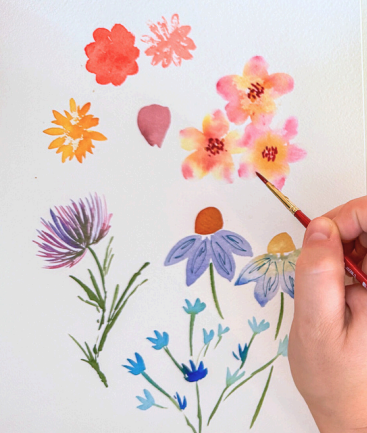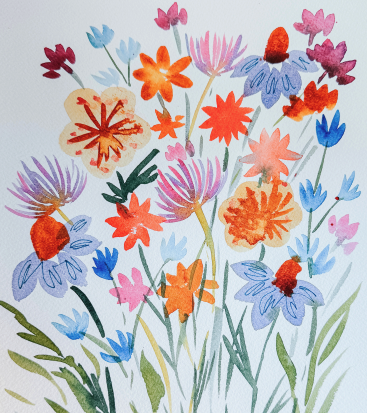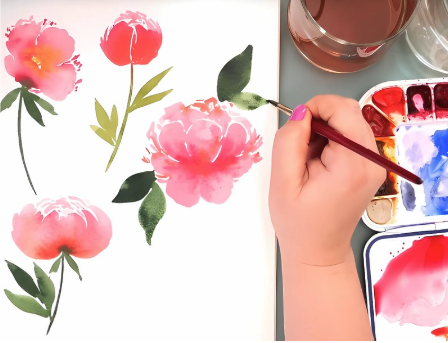Painting beautiful flowers with watercolor is the ultimate dream for many watercolor beginners. But when you actually sit down with your brush, it can feel…overwhelming. Where do you even start? How do you get the colors to blend just right? Why do your roses look more like blobs than flowers? If you’ve ever felt this way, you’re not alone!
In this post, I’ll guide you through the basic things you need to know to start painting gorgeous flowers in watercolor. And I’m going to let you in on a little secret…
Flowers are one of the best subjects for beginners because once you get the hang of it, it’s easy to create beautiful watercolor paintings that you’re proud of.

In this blog post we’ll hit on a few main topics:
Terms: We’ll set the foundation by learning some floral watercolor terms
Tips: I’ll share 4 tips for floral watercolor painting
Tutorials: Lastly, you’ll find tons of step-by-step tutorials so you can start painting flowers today!
Ready to get started painting something beautiful? Let’s dive in!
Floral Watercolor Terms
Let’s start by breaking down a few key floral watercolor terms that you’ll need to know.
Loose and Realistic Painting
Watercolor flowers can be painted in a variety of styles, but two of the most common are referred to as “loose” and “realistic.”

Loose watercolor focuses on expressive brushstrokes, minimal detail, and soft, flowing shapes. It captures the essence of a flower rather than precise details, making it a great choice for beginners who want to experiment with fluidity and movement. Typically, you won’t have a sketch or drawing with loose florals. Instead, you’ll be painting on a blank piece of paper.
Realistic watercolor, on the other hand, aims to capture a flower’s intricate details, shading, and colors. This approach requires layering, fine brushwork, and careful observation to create lifelike depth and form. This is a much more advanced technique, but even beginners can quickly work up to painting stunning realistic flowers with enough practice!
Here’s an example of one of my students in The Garden Studio who was able to elevate her loose painting skills and create beautiful realistic watercolors in less than a year!
Click here to learn more about The Garden Studio!
Artist: Deb Schwartz
One year of progress after joining The Garden Studio
Composition
Composition refers to how elements are arranged within your painting. A well-balanced composition guides the viewer’s eye along the page and creates harmony in your artwork. I have an entire blog post about composition here, but for now I just want you to be familiar with the term!
Perspective
Perspective is the way objects appear in relation to each other based on their position, angle, and distance from the viewer. When thinking about how to draw flowers, most beginners will picture a cartoony daisy. That kind of flower is situated so that it’s facing directly towards the viewer, but in nature, you rarely view flowers dead-on like that. It’s more likely that you’ll find flowers blooming at different angles, so it’s helpful to capture that using perspective.
Learning how to draw and paint flowers in different perspectives will enhance your paintings and make them appear more 3D and lifelike – even if you’re painting in a loose style.

Floral Watercolor Tips
Tip 1: Start with Simple Shapes
Flowers can seem complicated, but at the end of the day, they’re just a collection of basic shapes arranged in a way to make them recognizable as flowers. When you think about it that way, it makes the whole process feel way less intimidating!
Learning how to break flowers down into basic shapes is going to help remove the overwhelm and make them easier to paint. In my floral watercolor tutorials, I always start by breaking the flower down into basic shapes and teaching how to paint it in different perspectives. Look for basic shapes like circles, rectangles, and triangles to block them into the right spaces.
Tip 2: Use High-Quality Watercolor Paper
Watercolor works best on artist-quality, 100% cotton watercolor paper (140 lb or higher) because it absorbs the water well and allows the paint to stay wet for longer. This gives you more flexibility with your paintings. I hear from so many beginners who are frustrated with their progress, and a majority of the time, they’re not doing anything wrong – they’re just working with low-quality paper. It truly can make or break your painting process! Click here to get my watercolor supply guide!
Tip 3: Leave White Space in Loose Paintings
White space is your best friend! Especially when painting loose paintings. This allows the pigment to have some breathing room and the white space actually defines where the petals are so that the shapes you’re painting feel recognizable as a flower.
One of the biggest mistakes I see beginner watercolor artists make is not leaving any white space in their paintings which is when your lovely flowers can quickly move into unrecognizable blob territory.
Tip 4: Get Comfortable with the Watercolor Basics
If you’re brand new to watercolor and aren’t yet comfortable with watercolor supplies, I’d recommend you check out this post about watercolor techniques for beginners. You’ll learn foundational techniques like the wet into wet method and wet on dry painting. You’ll also learn about different brushstrokes that will become the foundation of your floral paintings!
Tip 5: Practice Drawing Flowers in Different Perspectives
Drawing doesn’t always feel like the most fun part of creating art. Most of us got into this because we wanted to paint! But trust me when I say, getting comfortable with drawing is going to take your floral watercolor game to the next level. It can take some practice, but I have a lot of free resources available to help you get started.
I have two blog posts about botanical drawing in perspective – one is about drawing leaves and one is about drawing disc shaped flowers. Both of these are great resources to start with, and you can also learn more in the step-by-step tutorials I’m sharing below!
Step-by-Step Floral Tutorials
Now that you’ve learned the basic principles of floral watercolors, it’s time to start painting! Next, I’ll share a few step-by-step flower tutorials to help you get started.
If you’re brand new to watercolor, I’d recommend starting at Level One and going up from there. If you have a little watercolor experience, Levels Two and Three will be great for you!
Make sure to bookmark this post so you can come back to these tutorials again and again. When you’re ready for more, check out my classes and watercolor membership to advance your skills!
Level One: 5 Simple Watercolor Flowers
I created a comprehensive ebook guide to painting simple flowers that you’re going to love if you’re a complete beginner. You’ll be able to learn the basics of floral painting and complete a beautiful piece, even if you’ve never picked up a brush.
Get the Free Guide to 5 Simple Flowers
Level Two: Loose Roses & Peonies
Two of the most popular flowers to paint are roses and peonies. I’ve put together two step-by-step tutorials on how to paint these gorgeous flowers. Once you master these two flowers, I have a hunch that you’ll be hooked on floral painting. 😉
Watch the Loose Peony Video Tutorial
Download the Loose Rose Photo Tutorial
Level Three: Wildflowers
When you’re ready for more, I have a whole collection of full-length wildflower tutorials on my YouTube channel! These videos include in-depth instruction on drawing in perspective, watercolor techniques, and much more! Pick your favorite flower from the list and dive on in!
Watch the Wildflower YouTube Classes

Enjoy practicing with these beginner tutorials, and when you’re ready for more advanced techniques, check out my full-length classes where I teach both realistic and loose floral painting styles.
I also host a botanical watercolor membership called, The Garden Studio, where artists learn along with me through hundreds of hours of educational content and new lessons every month.
This is the place to be if you want to paint watercolor flowers! Enrollment opens a few times a year. You can learn more and get on the waitlist here!



















